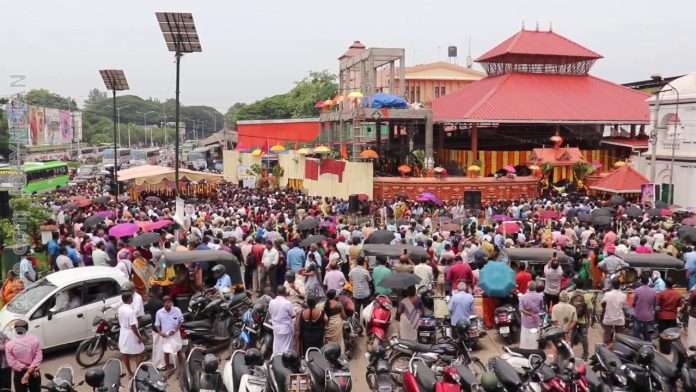Whilst we are generally travelling northwards in Kerala, in our very brief exposure to the old temples, let us take one more, small trip down south to Thiruvananthapuram, to visit the Army Ganapathy.
This temple is located very close to the Padmanabha Kshetram, and devotees often make it a point to visit both temples in one visit. It is also called Pazhavangadi temple. The word comes from Pazham (fruit) and Angadi (market).
The main Deity of the temple, obviously, is Lord Mahaganapathy. The idol is installed in a seated posture, with the right leg in a folded stance. Other Deities worshipped at the temple include Dharmasasta, Goddess Durga and Nagaraja. The temple sculptures include 32 different forms of Lord Ganesha. Did you know that the temple exterior is black in colour? Quite surprising.
The devotees who visit this temple are overcome with the calm and peace of the pious atmosphere. They say that Lord Ganesha fulfils the deepest wishes and fixes the stubbornest problems of his devotees who visit Him at the Pazhavangadi Ganapathy Temple.
The temple traces its origins back to Padmanabhapuram, which was the capital of the erstwhile Kingdom of Travancore. Legend has it that the soldiers were disturbed by a Yakshi at night, while they were keeping guard. One night a soldier, while taking a bath in the river chanced upon an idol of Ganapathi, with the right leg in the folded posture, and took it with him to the fort. He remained unaffected by the Yakshi while keeping vigil that night; since that day all the soldiers began worshipping that idol. Soon a temple was built at that place.
So, when in 1795 the then King Karthika Thirunal Rama Varma decided to shift the capital of the Kingdom from Padmanabhapuram to Thiruvananthapuram for administrative purposes, the soldiers of the Travancore Army took their idol along and placed it just outside the boundaries of the main fort. The present temple was built in 1860 under the rule of King Ayilyam Thirunal Rama Varma and the responsibility of managing the affairs of the temple was given to the Travancore Army. When the Nair Brigade went to fight in the First World War, they didn’t leave without making the customary offerings of coconuts to the presiding Deity.
In 1935, when the Travancore Army came to be considered a part of State Forces, the administration of the temple was taken over by the latter. During Second World War, when soldiers from Travancore were sent as part of the State Forces, they continued with the tradition of taking blessings of Lord Ganapathi, before embarking on the arduous journey. After independence, when the forces were merged with the Indian Army in 1949, the responsibility of maintenance of the temple was transferred to the Indian Army. Even to this day, when most of the temples are managed by Travancore Devaswom Board, the Pazhavangadi Temple has defied the norms and is being managed by the Army.
Over the years, devotees from far and wide have been flocking to the temple to offer their prayers. It is believed that more than 3000 coconuts are offered a day to the deity. That is about 5 coconuts every minute. The right to take the coconuts offered to the temple is auctioned periodically. The income from this goes to the Madras Regiment of the Indian Army which has formed a Trust to help the needy.
Does the fact that the Army maintain a temple seem strange to you? Not really, when you realize that in most land areas belonging to the Services, there are Temples, Gurudwaras, Churches and Mosques. Onboard ships, however, the display of religious symbols is strictly prohibited. Those who have been to the Navy Nagar in Colaba may have seen this temple complex there.
Isn’t it true that our prayers become even more meaningful when you know that the fruits of your offerings benefit those, who need it most?



















































